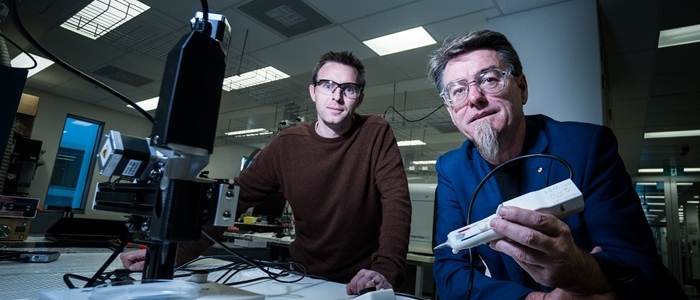News
3D printing bone tissue
Jun 28 2022
The team behind the Biopen, made up of researchers from the ARC Centre of Excellence for Electromaterials Science (ACES) at the University of Wollongong, St Vincent’s Hospital Melbourne and the University of Melbourne Department of Surgery have been named as finalists for the prestigious UNSW Eureka Prize for Excellence in Interdisciplinary Scientific Research for their cutting-edge handheld 3D printing device.

This collaboration draws upon the diverse skills of materials scientists, cell biologists, mechatronic engineers and clinicians to develop a handheld 3D printer, ‘the Biopen’, which can be used in surgery to repair damaged cartilage.
The device uses conventional 3D printing to create scaffolds that facilitate cartilage regeneration from adipose (fat) stem cells. This was developed with a view to preventing osteoarthritis and will have a significant impact on those suffering from the debilitating and painful condition.
“This project has involved many individuals over a significant number of years,” said ACES Director Professor Gordon Wallace.
“Together we are able to bring fundamental advances in science to tackle significant medical challenges.”
The nominated team is lead by ACES Director Professor Gordon Wallace and Director of Orthopaedics and Professor of Surgery at St Vincent’s Melbourne Hospital, Professor Peter Choong. The remainder of the team consists of Dr Claudia Di Bella, Dr Stephen Beirne, Dr Cathal O’Connell and Dr Zhilian Yue. These talented scientists will find out if they have taken out the title at the award dinner on Wednesday 30 August.
The UNSW Eureka Prize for Excellence in Interdisciplinary Scientific Research is presented to an individual or team who has produced a groundbreaking research outcome that was only possible as a result of the integration of two or more unrelated disciplines.
This is the second Australian Museum Eureka Prize nomination for ACES Director Professor Gordon Wallace who was nominated and won the CSIRO Eureka Prize for Leadership in Innovation and Science in 2016.
The multidisciplinary team will continue to develop the device through the convergence of their skills and experience – all with a common vision to produce a clinical solution to a big problem – cartilage regeneration.













